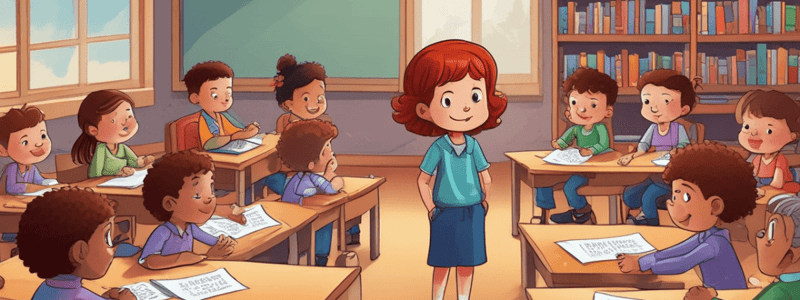Podcast
Questions and Answers
What is the most important stimulant for play in children?
What is the most important stimulant for play in children?
- Other kids to play with (correct)
- Structured learning sessions
- Elaborate toys
- Adult supervision
What do children learn through play that can't be taught in other ways?
What do children learn through play that can't be taught in other ways?
- Social skills and cognitive skills
- Happiness and essential behaviors
- Physical activity and motor skills
- Things that can't be taught (correct)
How can educators model social skills during play?
How can educators model social skills during play?
- By supervising children from a distance
- By providing elaborate toys
- By participating in play and narrating their actions (correct)
- By setting up individual activities
What is the benefit of role-playing different scenarios during play?
What is the benefit of role-playing different scenarios during play?
How can educators enhance cognitive skills through play?
How can educators enhance cognitive skills through play?
What is the benefit of interactive storytelling during play?
What is the benefit of interactive storytelling during play?
What do children learn about their body through physical activity during play?
What do children learn about their body through physical activity during play?
How can educators support physical development during play?
How can educators support physical development during play?
What is the incidental side benefit of play in children?
What is the incidental side benefit of play in children?
Why is it important not to push children too high during play?
Why is it important not to push children too high during play?
Flashcards are hidden until you start studying
Study Notes
Effective Transitions in Preschool Classrooms
- Transitions between activities are routine in preschool environments, but if not managed effectively, they can lead to disruptions and diminish the quality of the learning experience.
- Strategically planning and executing transitions can enhance classroom efficiency, foster a supportive atmosphere, and promote learning.
- To optimize transitions, it's essential to:
- Minimize unnecessary transitions by critically evaluating the daily schedule and identifying opportunities to consolidate activities.
- Implement staggered transitions to reduce chaos and stress, allowing children to transition in small groups or individually.
- Engage children during transitions using songs, stories, or interactive games to turn transition time into an extension of learning time.
Promoting Independence during Transitions
- Encouraging autonomy during transitions can enhance a child's confidence and self-management skills.
- Strategies to promote independence include:
- Providing opportunities for self-guided transitions, such as open snack times or self-service water stations.
- Using visual cues and simple checklists to support independent activities.
Schedules and Routines in Preschool Classrooms
- Routines play a critical role in preschool classrooms, contributing to effective management and educational success.
- Establishing consistent routines helps create a structured and predictable environment, essential for young children's emotional and cognitive development.
- Examples of routines in preschool classrooms include:
- Arrival and departure routines to help children transition between home and school.
- Bathroom and cleanup routines to instill good hygiene habits and responsibility.
- Nap time routines to regulate children's sleeping patterns and ensure they get enough rest.
- Meal and snack routines to promote healthy eating habits and social skills.
- Group time routines to foster a sense of community and promote cognitive and social development.
Visual Schedules in Preschool Classrooms
- Visual schedules are an effective tool in preschool classrooms, aiding in the management of daily routines and transitions while supporting the development of autonomy and predictability.
- Strategies to effectively integrate visual schedules include:
- Making visual schedules part of the daily routine to enhance children's understanding of the day's structure.
- Making visual schedules fun and interactive to keep children engaged and interested.
- Providing personalized visual schedules for children who need additional support.
- Communicating visual schedules with adults to ensure consistency between home and school.
- Assigning job charts to give children a sense of responsibility and importance in the classroom community.### Visual Schedules
- Using a visual schedule helps children understand the sequence of the day
- It can be used for the entire day, morning routine, bedtime routine, or any specific time
- Consistency is key; refer to the schedule throughout the day
- Some children may need to see the entire day's schedule, while others may only need reminders
- A visual schedule can be made to fit the needs of each family or classroom
Supporting Play
- Supporting play involves structured interactions to guide children in learning essential social skills
- Educators can model behaviors like sharing, taking turns, and collaborating by participating in play
- Roleplaying different scenarios helps children practice and understand social situations, developing empathy and communication
- Open-ended questions during play encourage children to think critically and develop problem-solving skills
Cognitive Development
- Play enhances cognitive skills through problem-solving activities
- Puzzles, strategy games, and building projects challenge children to think critically and develop analytical skills
- Educators can ask open-ended questions to encourage children to explore different possibilities
Communication Skills
- Interactive storytelling enhances verbal skills, encouraging children to articulate their needs and express their thoughts
- Play provides a platform for children to practice listening and responding
- Educators can guide children in developing meaningful conversations and understanding the flow of normal dialogue
Physical Development
- Play naturally involves physical activity, developing children's motor skills and body awareness
- Activities like climbing, sports, and arts and crafts enhance both gross and fine motor skills
- Educators can support physical development by encouraging participation in various physical activities and guiding children in practices that promote safety and body control
Studying That Suits You
Use AI to generate personalized quizzes and flashcards to suit your learning preferences.




